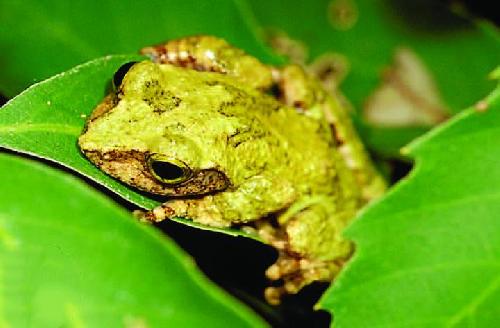Two endemic tree frog species, not recognised by science until now, have been identified in broadleaf forests in the island country of Taiwan. Unlike their siblings from mainland China and Southern Asia, they demonstrate reproductive behaviour, characterised with egg-eating (oophagous) tadpole embryos feeding on eggs, while still inside the mother's womb. What told them apart initially, however, were their gemstone-coloured eyes. The research team, led by Dr. Shu-Ping Wu, University of Taipei, have their study published in the open-access journal ZooKeys.
One of the new species, whose scientific name, K. berylliniris, translates from Latin to 'green-coloured iris', has been found to dwell among the leaves of moist forests in eastern Taiwan. It is a slender-bodied amphibian with the females slightly bigger than the males, measuring an average length of 41 mm versus 35 mm, respectively. Matching its emerald eyes is its body, which can be either dark green in colour, or deep tan. It is only the belly and the throat that, in contrast, are white and sometimes faintly speckled. On the other hand, its tadpoles vary from heavily dark brown to black.
The second new tree frog, called Kurixalus wangi after pioneer herpetologist Mr. Ching-Shong Wang, can be distinguished with its golden-yellow eyes and extraordinarily small body. Compared to its related species, this one measures an average of 30 mm for males and 34 for female individuals. Its upper-side body is brownish-green with deep brown and black spots, while its belly and throat - whitish.
 This is the emerald-eyed new tree frog species Kurixalus berylliniris. Credit: Dr. Shu-Ping Wu
This is the emerald-eyed new tree frog species Kurixalus berylliniris. Credit: Dr. Shu-Ping Wu
Both new frog species have been seen to lay their eggs in tree holes, but at different time of the year. The couple, described in the present paper, are also the first representatives of their genus found in the East-Asian country, although the scientists believe it is unlikely for them to be the only ones.
"The actual amphibian species diversity on the island of Taiwan is likely higher than currentlythought, given the diverse habitats and the dynamic history of geographic events," they argue. "Although Taiwan is a highly developed island with significant alterations to the natural landscape and destruction of critical habitats for amphibians, it is noteworthy that during the last fifty years, six of the seven newly described frog species in Taiwan were tree frogs inhabiting forested areas."
source: Pensoft Publishers